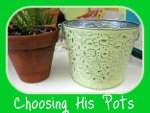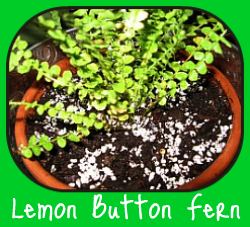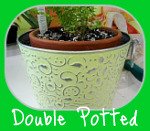Nephrolepis
Lemon Button Fern
a.k.a., Lemon Fern - Lemon Buttons - Erect Sword Fern
Nephrolepis cordifolia 'Duffii'
The Nephrolepis, or Lemon Button Fern, is one of the most pleasant small ferns an Indoor Gardener can grow. Once it finds its place in your home, and you establish its care cycle, it's pretty much care-free.
A small fern that grows to about a foot high and not much more across, it boasts tiny arching stems. Leaves are round with very small serrated edges that alternate up the stem.
When handled, there's a lemon scent, which - in addition to its yellowish gold color - gives the fern its name.
The Nephrolepis is the smallest of the Boston ferns and good for the beginning Indoor Gardener. The plant usually starts off in a small pot of no more than 4 inches, and never progresses much out of a 6- to 8-inch container.
Eventually, you might need to pot up to a 10-inch, but that's for an older plant. The Lemon Button Fern does well in terrariums, also.
Be careful not to confuse it with the Button Fern, Pallaea rotundifolia, which has glossier leaves and requires very different care. From a distance, it's easy to make the mistake.
Skip down to plant care section
| Batya's Personal Notes: (08-2010) A Sad Story of Mistaken Identity. I've had a little Button Fern for a few months, naming him "Mr. Pesky" because nothing I did for him seemed to make him happy. We tried four different locations and two different soil mixes.  He seems to like the kitchen table best, but that's a place he can't stay. There's a lot of bright, indirect light there, so I'm looking for a similar space in another room. He seems to like the kitchen table best, but that's a place he can't stay. There's a lot of bright, indirect light there, so I'm looking for a similar space in another room.
He's also been quite jealous of the other plants I've repotted and though he wasn't root-bound, I finally potted him up. He hated that container, though, drooping and dropping fronds. The second is a terracotta pot that I put into an outer tin container, with stones on the bottom for humidity. You can see the process in the photos. He perked up a bit, but that was short-lived.
At this point I was getting rather frustrated, not knowing what else to do for him. I checked all my sources - it seemed I was following all the directions for correct Button Fern care. He looked just like the photos - almost. Something on the edge of my awareness had me go a bit deeper in my Internet research. "Lemon Button Fern" with a different taxonomy altogether kept popping up in my searches. On a whim, I clicked on some of those pages. These photos looked like my plant, too!
Now that he's properly named and the watering schedule, humidity level, and soil mixture adjusted, my Lemon Button Fern - Nephrolepis - is recuperating very well. The lesson I learned: Pay more attention to the plant and less to the books! Second lesson learned: Try not to buy plants in general home-improvement stores whose labels, at most descriptive, say "Fern." |
For the Indoor Gardener
CARE / SPECIAL NEEDS
Watch the base of the fronds. If they turn brown, you're either under- or over-watering. Care for the Lemon Button Fern is similar to that for any of the Boston Ferns, but as with any plant, pay attention to its particular needs in your location.
- LIGHT: low, filtered shade; no direct afternoon sun
- WATER: moderate; keep soil moist - don't let it dry out; don't allow it to get soggy
- SOIL: mix peat moss into potting soil; well draining
- HUMIDITY: high; use gravel tray
- MISTING: only if home air is very dry
- FERTILIZER: spring-early fall, once per 3-4 weeks; liquid fertilizer, half strength
- TEMP: 60s - high 80s
MAXIMUM DIMENSIONS
- HEIGHT: 6-12 inches
- WIDTH: 12-18 inches

HEALTH:
- usually pest free
- possible summer aphids
COST: inexpensive
PROPAGATION
- NATURAL: Tubers can start new plants
- HOUSEPLANT: Divide rootball
FLOWERS: None
FRIENDLINESS FACTOR:
- As long as you don't mistake the Nephrolepis for the Button Fern as I did, this is an easy-to-get-along-with houseplant for the beginner Indoor Gardener.
- Non-toxic to pets.
- Plays well with others, either in terrariums or combination plantings.
CONVERSATION VALUE: Medium
Due to its small size, the Lemon Button Fern can easily live on a side table in a sitting area or serve as a low-height centerpiece during an intimate dinner.
DECORATION SUGGESTIONS:
- Small containers, 6 - 8 inches
- Small hanging baskets
- Tree fern fiber basket
- Terrariums

For Botanists, Scientists,
Outdoor Gardeners,
and School Reports
ORIGIN:
Nephrolepis cordifolia 'Duffii' is a cultivar; its natural predecessors are from the West Indies, Florida, Central America, South America

NATURAL GROWTH (OUTDOORS)
- spreads by underground tubers
- spore dispersal
- grows on rock, soil, palms
- evergreen
- spores look like small dots around the leaf edges
CATEGORIZATION:
There's some disagreement on the Family, Subfamily, and even Phylum levels among sources. Here are all of them:
-
KINGDOM: Plantae
PHYLUM: Pteridophyta / Polypodiopsida
CLASS: Filicopsida
ORDER: Polypodiales
FAMILY: Polypodiaceae / Nephrolepidaeae / Dryopteridaceae / Oleandraceae
SUBFAMILY: Nepetoideae / Lomariopsidaceae
TRIBE: Nepeteae
GENUS: Nephrolepis
SPECIES: cordifolia
CULTIVAR: 'Duffii'
Click here to read our Disclosure Statement. If you're serious about growing ferns and their magazine
- or someone you know is -
a membership and subscription to the
American Fern Society
is just about essential.
Keep up with new varieties to grow, techniques for planting,
and how to maintain health for your ferns.
The magazine provides info for
both indoor and outdoor enthusiasts.
DISCLAIMER:
Indoor-Gardener.com reports information from research and does not guarantee any of the plants mentioned, for medicinal, decorative, or other uses. Neither the FDA nor any physicians have endorsed the uses of plants mentioned on the website. Use plants as food or medicinal products only at your own risk.
If you're an Indoor Gardener
who likes to "keep it in the family" -
look into the
Rabbit Foot Fern
,
a close cousin in the
Polypodiaceae family of ferns
(at least according to some sources).
Return from Nephrolepis - Lemon Button Fern to
Indoor Gardener Home Page
 I swear, though, that he wanted "bling." Who would ever imagine a houseplant wanting Bling? Just on a whim I wrapped a very colorful, wiggly, thin gift ribbon around the tin planter and Mr. Pesky looked remarkably better. That ony lasted a while.
I swear, though, that he wanted "bling." Who would ever imagine a houseplant wanting Bling? Just on a whim I wrapped a very colorful, wiggly, thin gift ribbon around the tin planter and Mr. Pesky looked remarkably better. That ony lasted a while.
 On closer examination, though, after enlarging the photos and reading more details I realized that it was no wonder that my Button Fern was so pesky - he wasn't a Button Fern at all!
On closer examination, though, after enlarging the photos and reading more details I realized that it was no wonder that my Button Fern was so pesky - he wasn't a Button Fern at all!



